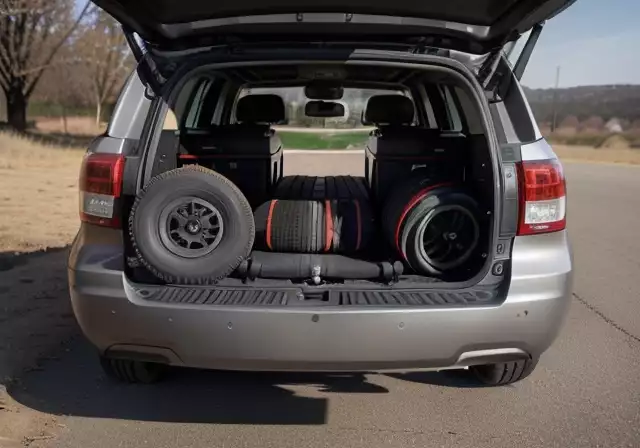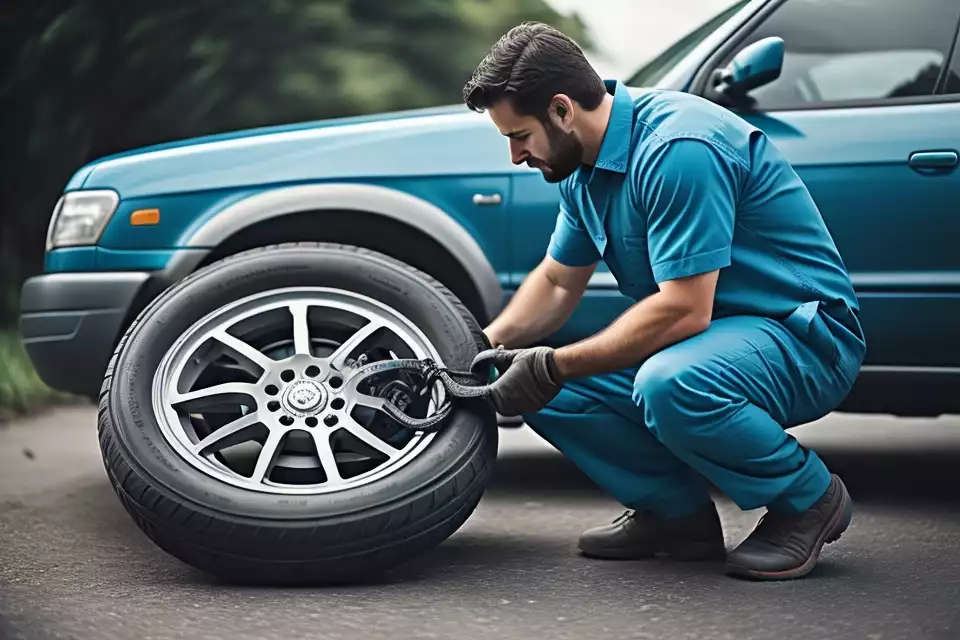So your tire blew out on the highway and now you’re stuck on the side of the road, hazard lights blinking, wondering how you’re going to change this thing and get back on your way. Don’t worry, we’ve got you covered. Changing a tire may seem like a daunting task, especially if you’ve never done it before, but with the right tools and a little patience, you’ll be rolling again in no time.
Grab your owner’s manual, the jack, lug wrench, spare tire, and roadside emergency gear from your trunk, and let’s get to work. Ignore all those dramatic tire-changing scenes in movies and TV shows – if you follow the proper steps, the whole process should only take around 15 to 30 minutes for most vehicles.
Stay calm, be safe, and before you know it, you’ll be thanking yourself for learning this simple skill that can get you out of a bind. Now roll up those sleeves and let’s get your hands dirty!
The first thing you’ll want to do is pull over to a safe spot, away from traffic. Turn on your hazard lights for safety.
Next, locate your jack, lug wrench, spare tire, wheel chocks, and wheel bolts in your trunk. Make sure you have all the necessary equipment before starting. If anything is missing, call for roadside assistance instead of attempting to change the tire yourself.
Place wheel chocks on each side of the front tires to prevent the vehicle from rolling. Then, loosen the lug nuts on the flat tire, but do not remove them yet.
Position the jack underneath your vehicle according to the owner’s manual. For most cars, the jacking points are next to the flat tire. Raise the jack until the flat tire is just off the ground.
Fully remove the lug nuts and set them aside. Remove the flat tire and put the spare tire on the lug bolts. Hand-tighten the lug nuts onto the bolts.
Lower the jack until the tire is on the ground, then tighten the lug nuts in a star or criss-cross pattern with the lug wrench. Replace the tools and flat tire in the trunk.
Remove the wheel chocks and you’re ready to go. Drive to a repair shop or dealer as soon as possible to have the flat tire repaired or replaced. Driving on a spare tire is not recommended for long distances or high speeds.
Take it slow getting back on the road. You’ve had a stressful experience, so give yourself a few minutes to relax before continuing your drive. But you did it – you successfully changed your own tire! Feel a sense of accomplishment in gaining this useful skill.

Now that you’ve gathered your tools, it’s time to locate your spare tire and jack. Pop open your trunk—for most cars, the spare tire and jack are stored under the trunk floor. If you don’t immediately see them, check your owner’s manual for the exact location.
Once you’ve found the spare tire, make sure it’s in good condition and properly inflated. The last thing you want is to go through the hassle of changing your tire only to find out the spare is flat too! If it looks damaged or worn down, it’s best to replace it.
Next, find the lug wrench and jack. The lug wrench is what you’ll use to loosen the lug nuts on your flat tire. The jack is what lifts your car so you can remove the flat tire. Place the jack underneath your vehicle according to the owner’s manual. For most cars, the jacking points are next to the flat tire.
Positioning the Jack
Make sure the jack is placed on a solid, flat area of the frame near the flat tire. As you raise the jack, check that it remains properly positioned. Once the flat tire is off the ground, have someone slide the spare tire underneath, then slowly lower the jack until the spare tire is on the ground.
Remove the lug nuts and set aside. Now you can fully remove the flat tire and slide on the spare tire. Hand-tighten the lug nuts on the spare, then lower the jack completely. Tighten the lug nuts in a star or criss-cross pattern with the lug wrench. Double-check that they’re secure, put away your tools and spare tire, and you’re ready to hit the road again!
The lug nuts are what hold your tires onto your wheel hubs. Before jacking up your car, you’ll need to loosen these lug nuts. This may require some elbow grease, so be prepared!
Gather Your Tools
For this step, you’ll want:
- A lug wrench (usually comes with your spare tire)
- A breaker bar for extra leverage (optional, but helpful)
- Wheel chocks to block your tires
Loosen the Lugs
- Park on a level surface and engage your emergency brake.
- Place wheel chocks on each side of the front tires to prevent the vehicle from rolling.
- Position the lug wrench over one lug nut. Place the end of the handle in the breaker bar for extra torque.
- Push down on the wrench to loosen the lug nut. Turn counterclockwise. If it’s stuck, you may need to jump up and down on the end of the wrench to initially loosen it.
- Loosen each lug nut about 1/2 turn before jacking up the vehicle, but do not remove the lug nuts yet.
- Repeat the same process for the remaining lug nuts. Double-check that all lug nuts have been loosened before jacking up your vehicle.
- Now you’re ready to jack up your vehicle and remove the lug nuts to take off your flat tire. Be very careful when removing the lug nuts, as the wheel may shift once they are off. Remove them in a star or criss-cross pattern.
By properly loosening your lug nuts before jacking up the vehicle, you’ll make the tire-changing process quicker and safer. Take your time – rushing this step could lead to stripped lug nuts or a wheel that falls off when you don’t expect it! Following these instructions carefully will have you back on the road in no time. Let me know if you have any other questions!
When it’s time to change your tire on the side of the road, jacking up your car is one of the most important steps. You’ll need to raise your car high enough to remove the flat tire and put the spare tire on.
Following these steps carefully will allow you to change your tire safely and get back on the road. Take your time and be cautious when jacking up your vehicle—your safety is the top priority. If at any point you do not feel comfortable changing the tire yourself, call for roadside assistance instead.

Removing a flat tire and putting on the spare is something every driver should know how to do. While it may seem daunting, with some patience and the right tools, you’ll be back on the road in no time.
First, park the car on a level surface and engage the parking brake. This ensures the car won’t roll while you’re changing the tire. Then, retrieve the jack, lug wrench, spare tire, and wheel chocks from the trunk. The lug wrench is the tool used to loosen the lug nuts that secure the wheels. Place wheel chocks on each side of the front tires to prevent the car from rolling.
Next, loosen the lug nuts on the flat tire, but do not remove them yet. Only loosen them about 1/2 turn before jacking up the car. Then, position the jack underneath the vehicle according to the owner’s manual. For most cars, the jacking points are next to the flat tire. Raise the jack until the flat tire is just off the ground.
Now fully remove the lug nuts and set them aside. Remove the flat tire and put the spare tire on the lug bolts. Hand-tighten the lug nuts onto the bolts. Lower the jack until the tire is on the ground, then tighten the lug nuts firmly in a star or criss-cross pattern with the lug wrench.
Replace the tools and flat tire in the trunk as soon as possible. Has the flat tire been repaired or replaced? Driving on a spare tire or uneven tires can damage the differential or transmission.
With some patience and by following the proper steps, you’ll be back on the road quickly after changing a flat tire. Be safe – if you do not feel comfortable changing a tire yourself, call for roadside assistance instead. But knowing how to do it yourself can give you confidence and independence in any driving situation.
Once you have the flat tire off and the spare tire in place, it’s time to put the lug nuts back on. These lug nuts, or wheel bolts, secure the wheel to your vehicle’s wheel hub or axle. Getting them on snugly and securely is crucial for safe driving.
Hand-Tighten the Lug Nuts
Place the lug nuts on the wheel bolts and tighten them by hand as much as you can. Make sure the tapered end of the lug nut is facing outward, away from the wheel. Tighten in a star or criss-cross pattern for the most even fit.
Tighten the Lug Nuts in Stages
Now it’s time to fully tighten the lug nuts. This should be done in stages using a lug wrench or impact wrench. Tighten each lug nut a little at a time, in the star or criss-cross pattern. Do two or three rounds of tightening until they feel very snug.
For the final tightening, put some muscle into it. Place the lug wrench securely over each lug nut, brace yourself on the ground or tire for leverage, and push/pull to tighten as much as you can. The lug nuts should be very difficult to tighten further by hand at this point.
Double Check Your Work
Once all lug nuts have been tightened, lower the vehicle to the ground by jacking up the axle again. Remove the jack stands. Jump up and down on the bumper or push on the tire to settle the wheel.
Then recheck each lug nut with the lug wrench to make sure they are still secure. Tighten as needed. It’s critical that lug nuts are tightened to the proper specifications to avoid the wheel coming loose while driving.
After driving a short distance, pull over and recheck the lug nuts again. Then you should be all set to get where you need to go! Double-checking your work will give you peace of mind that the wheel is securely fastened for a safe journey ahead.
Once you have the spare tire out and the lug nuts removed from the flat tire, it’s time to jack up your car and remove the flat tire.
Loosen the lug nuts
Before jacking up the car, loosen the lug nuts on the flat tire about 1/2 turn. Don’t remove them yet. This will make it easier to remove the lug nuts once the flat tire is off the ground.
Position the jack
Place the jack underneath your vehicle’s jacking point for the flat tire. This is usually indicated in the owner’s manual. Common jacking points are the axle, frame or lower control arm. Ensure the jack is directly under the jacking point to avoid bending or damaging parts of your vehicle.
Raise the jack
Raise the jack until the flat tire is just off the ground. Double-check that the jack is secure and stable before removing the lug nuts.
Remove the lug nuts and flat tire
Remove the lug nuts and set aside. Pull off the flat tire and set it aside.
Mount the spare tire
Line up the spare tire and hand-tighten the lug nuts to hold it in place. Lower the jack until the spare tire is on the ground, then tighten the lug nuts in a star or criss-cross pattern with the lug wrench.
Lower your car and tools
Slowly lower the jack until it’s fully retracted. Replace the tools and spare tire in your trunk. You’re now ready to drive to have the flat tire repaired or replaced.
Changing a flat tire typically takes between 15 to 45 minutes for a regular passenger vehicle, depending on your experience level. The actual process of jacking up the car and swapping out the flat tire only takes about 10 to 15 minutes.
The additional time accounts for gathering your tools, ensuring you have the right spare tire and pressure, and driving to have the flat tire serviced. With some practice, you’ll get quicker at it and be back on the road in no time.
Once you’ve gotten your spare tire out and jacked up your car, it’s time to get that new tire put on. Here are the steps to get you back on the road:
Remove the lug nuts that secure the flat tire to the wheel hub. For this, you’ll need a lug wrench or tire iron. Loosen the lug nuts before jacking up the car, but do not remove them yet.
Raise the vehicle with a jack until the flat tire is off the ground. Double-check that the jack is placed properly under the vehicle’s frame to ensure stability.
Fully remove the lug nuts and set them aside. Take off the flat tire and put the spare tire on the wheel hub.
Hand-tighten the lug nuts onto the spare tire. Lower the jack until the tire is on the ground, then tighten the lug nuts in a star or criss-cross pattern with the lug wrench.
Double-check that the lug nuts are tightened to the recommended torque, which is usually around 80 to 120 foot pounds for most passenger vehicles. This helps ensure the wheel is securely fastened to the wheel hub.
Put away your tools and spare tire. Store the flat tire in your trunk to have repaired or replaced.
You’re now ready to get to your destination or the local tire shop. Most tires can last 3-5 years, so if your spare tire is near or past this age, it’s a good idea to get a new full-size replacement tire installed as soon as possible. Driving on an old spare tire for an extended time or at high speeds is not recommended and could be unsafe.
Getting a flat tire is never convenient, but changing it yourself can save time and money. Be safe by pulling over to a level spot, engaging your hazard lights, and releasing the brake lever. Take your time and follow all directions to change your tire properly. You’ll be hitting the road again in no time!
Changing a flat tire is one of those tasks that always seem to take longer than you expect. The actual process of removing your old tire and putting the spare on typically only takes around 15-20 minutes for someone with a bit of experience. However, there are a few extra factors that can add time. Here are some of the most common questions about how long it really takes to change your tire:
In the end, you can expect to spend 30-45 minutes changing your own tire if you’re comfortable doing it yourself and have the necessary tools and information on hand. But for many drivers, calling for roadside assistance is the most prudent option to get back on the road as quickly and safely as possible.
Conclusion
Changing a flat tire is simpler and quicker than you may think. With the right knowledge, you can handle this roadside inconvenience confidently. In 30 minutes or less, you’ll be back on the road, proud of your new skill and ready to share your adventure with friends.
So, next time you encounter a flat tire, don’t fret. Take a moment to stop, gather your tools, and tackle the situation like a pro. You have the capability to overcome this challenge and emerge victorious.

